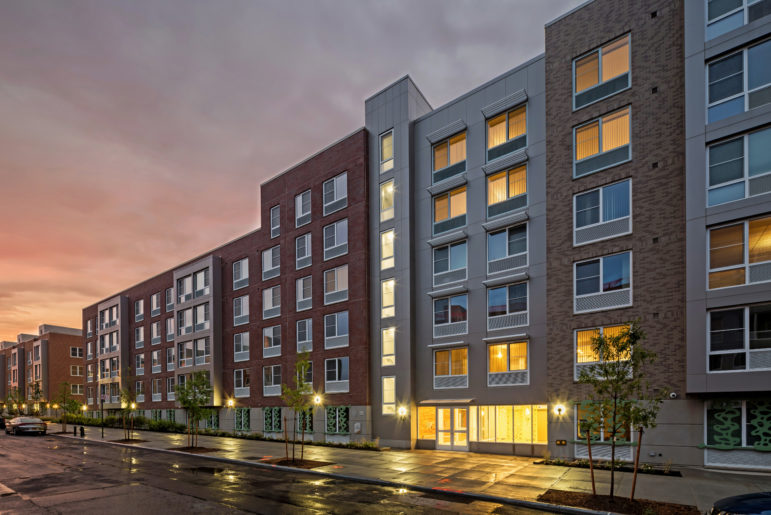
Burita Media
A rendering of the coming Prospect Plaza development.
It is often said that your ZIP code is a better predictor of your health and life expectancy than your genetic code. For that reason, we believe Dr. Ben Carson’s background as a pediatric doc will help him see the link between health and housing as the newly appointed U.S. Secretary of Housing and Urban Development. That is, the physical and mental well-being of someone’s home can have a strong bearing on an individual’s success and upward mobility.
Leaders in affordable housing development are highlighting a direct relationship between the design of affordable housing that promotes resident health and potential cost savings for developers, tenants, and public and private health providers.
Affordable housing represents an essential platform and opportunity to address in our inner cities and rural areas the needs of populations with some of the greatest health risks. Low-income communities continue to face a disproportionately higher burden of chronic diseases, such as heart disease, cancer, and diabetes. The challenge, however, is that in many low-income and minority communities, it is difficult to find resources such as safe, walkable streets, well-maintained playgrounds and recreation spaces, or access to healthy food.
The design of communities and homes is a crucial component to promoting health equity, and addressing the social determinants of health that have implication for the well-being of children and families.
The Partnership for a Healthier America is working with developers to prioritize key design elements that can have a big impact on resident’s health with minimal costs to the developer. These include features such as facilities for physical activity, well-designed stairs that encourage everyday use, infrastructure to support walking and biking and free, and low-cost programming to support resident health.
One pilot study conducted by Icahn School of Medicine at Mount Sinai in the South Bronx found that on average, 58 percent of residents reported an increase in the number of flights they ascended per week in an Active Design building compared to 20 percent of residents in a control non-Active Design building.
These developers are aligned with a growing movement that supports healthy, active environments and homes for children and families. A perfect example is Prospect Plaza, a development led by Blue Sea Development in Brownsville, Brooklyn, which had the highest death rates of preventable diseases, as compared to the rest of New York City.
Residents at Prospect Plaza earn an income level of below 60 percent of the median income, or $51,450 for a family of four. Twenty five percent of units are set aside for residents from the local NYC Housing Authority buildings, 50 percent for those coming from the local neighborhood, 5 percent for those who are physically disabled, and 2 percent for those who are hearing or visually disabled.
Residents of Prospect Plaza will be able to access 24,000 square feet of supermarket/retail space and an 8,400 square foot community facility by project completion. The development will be comprised of five buildings across three adjacent blocks, a massive undertaking that will provide neighborhood-level healthy opportunities for residents to be active, access healthy food, and engage with neighbors. Two of the buildings within the development have been completed to date. One resident, Kiana, said that before moving into her apartment in Prospect Plaza, she had to take her daughter, Jada, on a bus and a train just to play at a park. Now she simply walks outside.
A similar story is found in Denver, CO, where Urban Ventures built a community with 452 units that provide increased access to healthy food options and integrated healthcare services for a multi-generational, mixed-income community. The development includes a community center with indoor exercise equipment for adults and children and a kitchen area where healthy cooking classes can be held; secure, long-term bike storage; and drinking fountains in areas designated for physical activity.
Developers are finding that affordable housing can not only improve the financial health of tenants, but also improve their physical health. Les Bluestone, co-founder of Blue Sea Development Company found that over time healthier tenants equated to a lower rate of rent delinquency, as compared with other buildings in his portfolio.
Secretary Carson and HUD should take note of this return on investment as they explore new approaches and innovations that can spark systemic change in affordable housing. Health-centered design may be part of a larger discussion on how to most effectively use limited resources. Regulatory and funding mechanisms could be employed to positively impact affordable housing and neighborhood development patterns. For example, Low- Income Housing Tax Credits (LIHTC) are critical to making affordable housing developments financially viable. The LIHTC program is administered at the state level, where criteria are developed for awarding tax credits. These criteria directly influence the siting and design of affordable housing in each state. States can impact residents’ health by refining them to elevate evidence-based, active-design strategies.
Home and personal well-being go hand in hand. The empowerment of improving tenant financial health and physical wellness for tenants while saving costs for developers and taxpayers is a win-win that should be recognized. It comes at an opportune time in affordable housing to ensure positive consequences for health equity, cost savings, quality of life, and community vitality.
Lawrence Soler is President and CEO of Partnership for a Healthier America.








